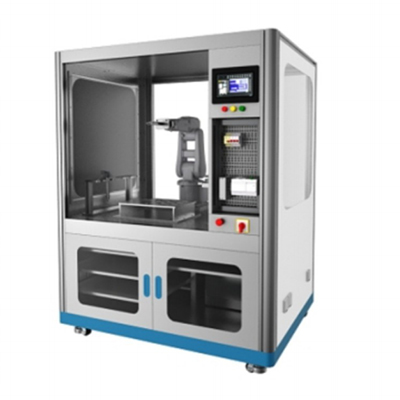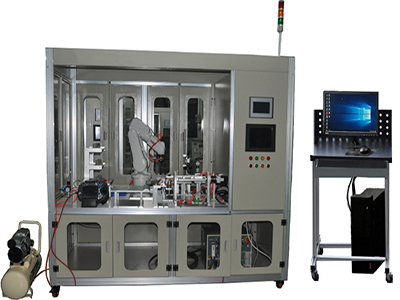This platform complies with the 1+X occupational skill standards for industrial robot application programming and meets the technical specifications for the industrial robot installation and programming competition. This industrial robot multifunctional teaching platform is mainly composed of an industrial robot, a basic platform, a pneumatic system, an electronic control and communication system, and safety protection.
GLIR-200 Industrial Robot Multifunctional Teaching Platform
This platform complies with the 1+X national vocational skill standard for industrial robot application programming and meets the technical specification requirements of the industrial robot installation and programming competition. This industrial robot multifunctional teaching platform is mainly composed of industrial robots, basic platforms, pneumatic systems, electronic control and communication systems, safety protection, etc. It can carry out training and assessment on industrial robot tool coordinate calibration, plane and curved trajectory programming and operation, assembly, handling, stacking, gluing, simulated rod connection, three-dimensional warehousing, visual sorting, etc. It can be used to train students to master the operation, programming, debugging, visual application, digital twin technology, PLC programming and application, touch screen configuration technology, sensor technology, pneumatic technology, motor drive technology, industrial Ethernet communication technology, etc. of industrial robots.
Ⅰ. Industrial robot body
1. Technical parameters of industrial robots: six-axis serial industrial robot with six degrees of freedom, maximum working radius: ≥700mm, repeat positioning accuracy: ≤±0.03mm, rated load: ≥6kg, communication method: MODBUSTCP/Ethernet.
Axis 1 Motion range Rotation +170°~-170° Maximum speed 370°/s
Axis 2 Motion range Vertical arm +70°~-110° Maximum speed 370°/s
Axis 3 Motion range Cross arm +120°~-70° Maximum speed 430°/s
Axis 4 Motion range Wrist +185°~-185° Maximum speed 300°/s
Axis 5 Motion range Wrist swing +30°~-200° Maximum speed 460°/s
Axis 6 Motion range Flip +355°~-355° Maximum speed 600°/s
2. Industrial robot control cabinet:
1) Integrated body safety circuit (emergency stop).
2) Built-in 16-way input/16-way output digital quantity.
3) Full Chinese interface, can switch to English interface.
4) Communication interface: RS485*1, RS232*1, LAN*1, PWM*1, HDSI*1
5) System process package: including welding process, palletizing process, grinding process, spraying process, visual process, etc.;
3. Industrial robot teaching programmer:
1) Provide teaching pendant secondary development kit and DEMO
2) Screen size: ≥8 inches
Ⅱ. Industrial robot supporting applications:
The multifunctional training workstation is equipped with standard workbench module, TCP module, trajectory module, execution module, writing board module, palletizing module, etc. to complete various robot applications.
1. Standard workbench module
1) Size ≥1800mm*1440mm*2000mm
2. TCP module
1) Material: high carbon steel, chrome-plated surface.
3. Trajectory training module
1) The trajectory path includes circles, triangles, complex contours and spline curves.
4. Writing board module:
1) Number of drawings: 8;
5. Quick-change tool module: composed of quick-change bracket, quick-change plate, etc. Different quick-change tools are provided according to different training objectives and operation objects.
6. Palletizing module, simulated material block, material PVC, size ≥50mm×20mm×15mm, quantity 6, can realize the transportation and palletizing training between two palletizing tables.
7. Belt transport module is composed of belt conveyor, sensor, etc. The speed regulating motor drives the belt conveyor to transport a variety of different parts.
8. Well feeder module, composed of well feeder sensor. It is used to store a variety of parts and control the feeding time according to the training requirements.
9. Rotary feeding module
1) Integrated design of stepper motor and reducer;
2) Speed: ≥20º/s;
10. Material module: composed of material placement tray and material block
11. Electrical control module
1) PLC: The control system should use high-performance fail-safe CPU as the control core to meet industrial safety standards, provide PROFINET communication interface, working memory 125KB, load memory 4MB, CPU onboard 14-point digital input, 10-point digital output and 2-point analog input interface, Boolean operation execution speed 0.08μs/instruction, move word execution speed 1.7 μs/instruction, real number mathematical operation execution speed 2.3μs/instruction.
2) Human-machine interface: PLC supporting brand ≥9 inches, program can be downloaded from the network.
3) Contains three-color indicator light and alarm buzzer prompt.
12. Assembly module: composed of pneumatic clamping mechanism, etc.
13. Storage module
1) Double-layer with 4 positions, using aluminum profiles as structural support;
Ⅲ. Supporting materials:
1. Industrial robot training guide.
2. Industrial robot operating instructions.
IV. Basic function module:
1. Provide feature capture function, which can quickly capture points, lines, surfaces, center of circle, coordinate system and other features, and measure angles and distances, and measure the distance between robot points.
2. Users can create and save components to form component libraries, support file imports including: stp, step, igs, stl, dxf and other standard CAD file formats, and users can build their own unique model library.
3. Imported models can be split, merged, aligned, joint axes can be established, auxiliary coordinate systems can be created, and series, parallel, and mixed structure robot models can be customized according to robot drawings and DH parameters.
4. Supports simulation of serial, parallel Delta and rectangular coordinate system SCARA, collaborative robots, spraying and other special robots, 5-axis-6-axis machine tools and other robots of different structural types and various motion mechanisms.
5. Covers most brand robots on the market (such as foreign brands: ABB, KUKA, Fanuc, Motoman, YASKAWA, Staubli, Nachi, OTC, Panasonic, etc., domestic brands: Efort, Estun, Siasun, Xinshida, Aobo, Liqun, Guangshu, Canopus, Luoshi and many other brands of robots), machine tools, conveyor belts, guide rails and other peripheral equipment model components, supporting customized development applications of all brand robots.
6. Secondary development: Provide SDK development package, which can be used for secondary development through languages such as C# and Python.
V. Offline programming function module:
1. Supports processing applications of various complex 3D models (such as 3D curves, surfaces, etc.), which can be imported into standard 3DCAD formats such as step, stl, iges, dxf, etc.
2. Can directly import 3D point cloud data to generate various processing paths.
3. Can calibrate the workpiece through single-point positioning and three-point positioning, so that the workpiece position in the software is consistent with the actual workpiece position.
4. Can extract the edge features of the 3D model to directly generate the robot processing motion trajectory for processes such as cutting and welding.
5. Supports mainstream robots and G code post-output, such as KUKA/ABB/STAUBLI/FANUC/KAWASAKI and other mainstream robots and Nabot, Baoyuan, Lianda, KEBA, B&R and other controllers and SIEMENS/Fanuc/SYNTEC/Lynuc/ACS and other 5-axis CNC systems, and can also develop various post-outputs according to customer needs.
Ⅵ. Production line planning function module:
1. Provides 3D model grid simplification function and observes the number of grids in the current model.
2. Provides model material color modification function and provides a rich model color library close to reality.
3. Point teaching programming can generate PTP points and Line points, and can be converted to each other. The robot end can be dragged to modify existing points.
4. When planning the production line, the processing path generated by offline programming can be called for simulation.
5. Custom material generation, parameterized control of material generation number, time interval, feeding speed, etc., can modify the material generation position.
6. Based on the real-time rendering engine and combined with VR3D visual technology, users can seamlessly switch the current scene to the three-dimensional illusion mode with one click; in this mode, users can experience scene roaming, dynamic simulation and interactive design operations.
Ⅶ. Training projects of industrial robot multifunctional teaching platform
(I)Mechanical and electrical installation and commissioning
(1) Installation and commissioning of industrial robot tool quick-change system
(2) Mechanical assembly of detection unit, sensor cable wiring and gas line connection
(3) I/O wiring of PLC control system
(4) Working origin posture of industrial robot
(II)Maintenance and operation of industrial robot
(1) Fine calibration operation of industrial robot
(2) Update operation of revolution counter
(3) TCP calibration of tool
(III)Palletizing of products
(IV)Warehousing of products
(V)Application of vision system
(1) Composition and connection of industrial vision system
(2) Experiment of detection process of industrial vision system
(3) Comprehensive application of vision system and industrial robot
(VI)Debugging of sensor equipment
(1) Experiment of robot grip
(2) Experiment of robot displacement
(3) Experiment of robot arm acceleration
(4) Experiment of displacement sensing
(5) Principles and applications of various motors
(6) Principles and options of sensors
(7) Installation and application of various sensors in the system

Synchronous PC version:
GLIR-200 Industrial Robot Multifunctional Teaching Platform https://www.biisun.com/home/category/detail/id/138.html


 Italian
Italian German
German Russian
Russian Turkish
Turkish Portuguese
Portuguese Spanish
Spanish French
French



